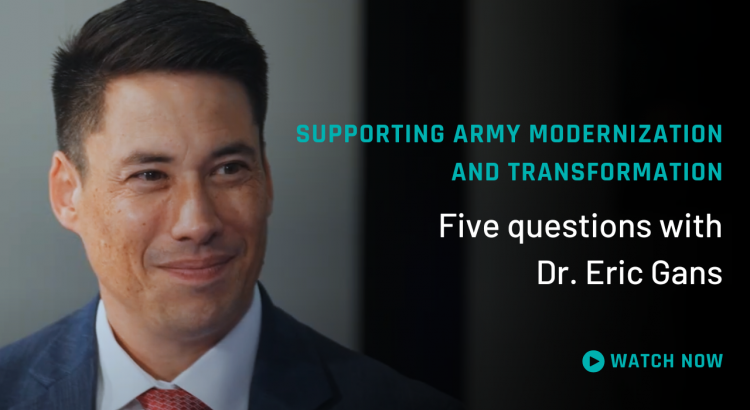
Reigniting the Defense Innovation Base for a New Industry Paradigm
Mark Aslett, Chief Executive Officer
April 1, 2020
Our industry finds itself at a critical juncture.
In recent months, the global pandemic COVID-19 has spread rapidly around the world, infecting and killing tens of thousands of people, with few signs of slowing. The global supply chain and many regional economies have ground to a halt as countries seek to mitigate the impacts of the virus. Like many other essential businesses, our industry has had to quickly assess the impact of COVID-19 and maintain continuity of mission-critical business operations, all while focusing on the health and safety of our employees.
However, even before the threat of a global crisis, companies have been operating within a new geopolitical paradigm, and the U.S. government has faced an entirely new generation of potential threats. In recent years, the global landscape has continued – if not accelerated – its shift to a multipolar structure led by a handful of primary adversarial powers. In parallel, the threats for which these powers are preparing are undergoing rapid and foundational change. From electronic warfare to space superiority, international governments are grappling with an increased set of unfamiliar risks and new battlespaces that necessitate a fundamental shift in their approach to national security.
The future remains uncertain, in large part due to this global crisis, and once we emerge from the pandemic, we must take a close look at the changes needed throughout the defense contracting industry to ensure its future success.
A Robust Industry – With a Need for Change
A paradox is manifesting itself in the defense contracting industry. Defined by historically consistent returns, our sector has traditionally been a healthy vertical overall. Defense companies have a distinct financial advantage – particularly compared to our commercially focused counterparts – because the DoD funds much of the upfront capital, R&D expenditure and production working capital for any given project. The DoD then purchases products at higher margins for many years as programs shift to production. Coupled with infrequent – albeit relatively expensive – upgrades, high-margin international sales and the fact that incumbents hold a distinct advantage in the industry, many defense contractors find themselves operating in a business-friendly environment.
Nevertheless, we are facing several new and growing potential vulnerabilities that require an evolved approach. In addition to the unknown future impacts of COVID-19, a growing national debt, historically low interest rates and increases in non-defense discretionary spending are potential headwinds in defense spending overall. Across the industry, we have continued to witness consolidation that winnows both the volume and diversity of technology providers. From Northrop Grumman’s acquisition of Orbital ATK, to the industry-altering mergers between Raytheon and United Technologies Corp. and Harris Corp. and L3, respectively, the number of innovative public-sector specialists has shrunk considerably in just the past few years.
Moreover, from a research and development standpoint, we’ve collectively settled for IR&D and capital expenditure rates of 2–3 percent as an acceptable status quo. However, we should not and cannot settle for rates that are inadequate for the goals we define for ourselves. For example, our high-tech counterparts on the commercial side regularly invest upwards of 10 percent of revenue on IR&D. With federal IR&D rates that pale in comparison, and acknowledging that the public sector is often too small and complex for high-tech commercial companies to penetrate, the defense industry finds itself at a distinct disadvantage for readily accessing the foremost technologies for mission-critical and national security needs.
A Long-Term Framework for Success
As new, emerging threats become more prevalent and require dedicated attention, contractors must make substantive investment in new technologies and innovations a strategic priority.
Complicating matters, the continued global spread of COVID-19 has posed an unprecedented acute threat to the vitality of our business and presents an issue we will need to collectively address. In its wake, we must evaluate the industry overall and must especially consider material and fundamental changes to our approach in order to ensure our long-term success, including:
- Evolving defense procurement and acquisition policies. Whether due to bureaucratic red tape, cumbersome regulatory policies or the complex nature of defense technology, there is a lack of defense industry participation among high-tech commercial companies. By creating ease of entry into the public sector, the addition of more high-end commercial expertise will challenge industry incumbents to innovate and deliver, driving the industry forward as a whole.
- Reestablishing and fostering a healthy, innovative mid-tier base. In some respects, industry consolidation has been a boon to the sector, increasing the scale of solutions that we’re able to provide to our customers. But what we’ve gained in scale we’ve lost in diversity and entrepreneurial spirit. In order to foster continued innovation, we must recognize the importance of and reestablish a robust mid-tier base.
- Making a greater effort to attract and retain talent by focusing on both innovation and purpose. Companies are only as successful as the people within them. We must not only undertake a dedicated effort to attract the foremost talent in technology, but also foster a culture of both purpose and innovation in order to retain and develop that expertise for years to come.
- Fostering partnerships with peers. Whether with traditional or non-traditional partners, as an industry, we must make every effort to collaborate with others – including commercial, government and academic entities – in a way that unlocks new efficiencies and increased investment to drive the industry forward.
Our industry finds itself with a steady track record of success but also a need to evolve to realize our collective potential.
Getting there will not be easy. It will require shifting priorities, making difficult decisions, forging new relationships and transforming our approach to the industry as we currently understand it.
As we look to the future and continue to function at the service of the public sector, these are vital decisions that will determine the success of our industry, and the defense industry’s capabilities, for decades to come.







 Enabling a Trusted Domestic Microelectronics Ecosystem
Enabling a Trusted Domestic Microelectronics Ecosystem